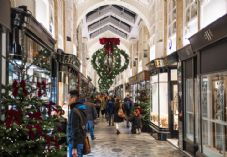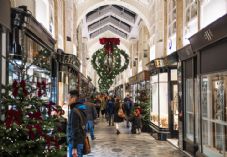UK DIY News
Footfall Forecast To Rise Nearly 50% When Retail Reopens

- The largest rise in footfall of +59% will be in high streets, as non-essential retail and outdoor hospitality open on same date, differing from lockdown 1 when hospitality opened two weeks after retail
- In shopping centres and retail parks footfall will rise by +46% and 26% respectively in the first week of reopening
- Springboard data reveals that at the end of lockdowns 1 and 2, footfall rose in the first week by more than +40%, however greater rises are expected due to the success of the UK vaccination programme and the concurrent opening of retail and hospitality
- The forecast increase in footfall means that footfall will be +128.5% higher than in the same week in 2020, although it will remain -61.8% below the 2019 level
The announcement of the date for the reopening of retail stores of 12 April will have brought a huge collective sigh of relief amongst all those involved in bricks and mortar retail. Finally retailers and destinations will be able to capitalise on the pent up demand amongst shoppers to return to stores. This pent up demand is evidenced by Springboard’s footfall data for the UK which identified that despite the lockdown with all essential stores closed, activity in UK destinations has increased from week to week for the past five weeks.
We know that online spending has increased hugely over the past year with over a half of all spending on non-food products going online in January. This increased shift online was not necessarily due the inherent attractiveness of online versus stores, but a result of the lack of virtually any other opportunity to shop for non-food products (unless you are able to purchase what you need from food stores, health food shops or pet stores).
On the back of this, when non-essential retail and outdoor hospitality reopens in England from 12 April we are forecasting that footfall across the UK will increase rise by up to +47.9% in the first trading week. This will equate to an increase in footfall of +128.5% from the same week in 2020 when we were three weeks into Lockdown 1, but it will still be -61.8% below the 2019 level.
Footfall in retail parks will rise by +26% in the first week, whilst in high streets and shopping centres footfall is likely to rise by significantly more than this (by +59% in high streets and by +46% in shopping centres). In the first week of reopening after Lockdown 1, footfall in high streets rose by +46.6%, however, we are forecasting an even greater rise in high streets this time as both non-essential retail and outdoor hospitality are both opening on 12 April, and of the three destination types high streets are best able to cater for both opportunities.
We expect that there will be a continued uplift into the subsequent week after reopening which starts Sunday 18 April, with footfall rising by a further +10.4%. This is slightly higher than the +7.1% seen in the second week of reopening after Lockdown 1, and is likely to be due to the fact that with children returning to school following the Easter holidays on Monday 19 April, many shoppers may choose to defer trips to the second week after reopening as they won’t have the tie of home schooling.
Springboard’s data has demonstrated that the longer consumers are subject to restrictions the greater the desire for freedom. In this lockdown footfall has risen each week for the past five weeks with footfall currently -62.1% below the level in 2020; and by the time stores reopened after Lockdown 1 footfall was -66.3% below the level in 2019 versus -82.2% in the fourth week.
With reopening occurring 14 weeks since the start of Lockdown 3 on 4 January, shoppers are likely to feel safer visiting retail destinations. The success of the UK vaccination programme which has seen over 60 million individuals vaccinated will put many at ease to get out to retail destinations, who might have previously hesitated. In addition, there is added confidence that retailers still have the appropriate social distancing measures in place from 2020, and shoppers have become more accustomed to wearing face coverings in all public locations.
With social distancing measures set to be eased by 21 June with a return to near normality and a government target to have all adults vaccinated with a first dose by 31 July, this will no doubt support footfall across all areas of the UK. Coastal towns are expected to receive a boost in footfall over the summer months due to staycations and footfall in regional cities will start to rise as some workers start to return to their offices, at least for part of the working week later in the year. Indeed, spending is likely to be boosted in the short term by the fact that many consumers who are in work have disposable income to spend that has not been used for holidays and other spending during the Lockdown.
In what has been a hugely challenging year for retailers both large and small, the retail industry is likely benefit from a surge back to stores as consumers rediscover their love for bricks and mortar stores, after many months of online shopping.
Diane Wehrle, Marketing and Insights Director at Springboard commented:
“As we approach the 12-month mark since the start of the pandemic in the UK, lockdown fatigue is at its height and the increases in footfall over the last five weeks have indicated the pent up demand for a return to normality. We know from when non-essential retail reopened at the end of Lockdowns 1 in June and 2 in December that footfall will rise sharply and we anticipate this will be more prominent than ever before with a rise of up to +47.9%.
“By mid-April, consumers will be looking for sensory and social retail experiences, reconnecting with their favourite brands and purchasing new wardrobes for a summer of social events. We are anticipating a strong initial uplift in April that will continue to rise over the summer months as the economy reopens in the UK.”
Source : Springboard
Image : VictorHuang / iStock 1265517689
I find the news and articles they publish really useful and enjoy reading their views and commentary on the industry. It's the only source of quality, reliable information on our major customers and it's used regularly by myself and my team.











































